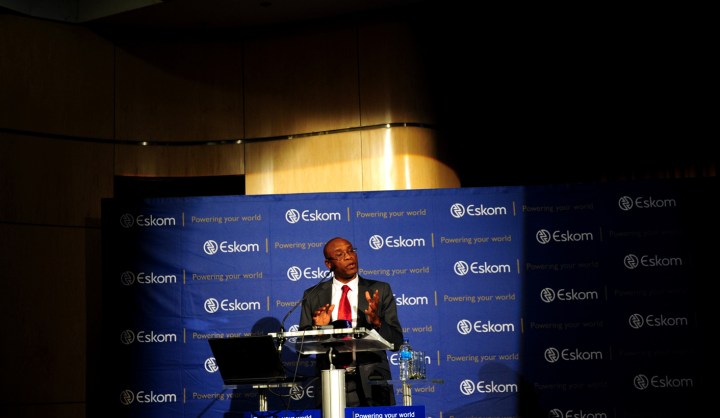South Africa
Eskom: Defending the indefensible is the hardest thing to do

Poor Eskom. The electricity parastatal is once again in the firing line as load shedding affects households and businesses across the country. Defending the organisation on Monday, Eskom leaders suggested it's not all their fault, government sets the policies. The current policies have us in a situation where load shedding is the new normal. You don't want to imagine what a crisis looks like. By GREG NICOLSON.
During President Zuma’s State of the Nation Address in June he said alleviating energy constraints was crucial to creating growth. “Radical transformation of the energy sector” would find the right balance between coal, solar, wind, hydro, gas and nuclear. Procurement would be fast-tracked, there’d be an injection of capital, skills, and redefined roles for stakeholders working together.
Yet there is no real plan. Speaking to media on Monday, as households and businesses suffered from the worst period of load shedding since 2008, leaders of Eskom continually referred to the issue of energy constraints as bigger than the utility. It relates to policy direction they have no control over, they said.
“What we do is by direction of policy. Where policy is uncertain it is very harmful,” said Eskom Chief Executive Tshediso Matona. The future of gas, coal, and nuclear remains uncertain. And while Matona said government was discussing the direction of energy, he didn’t know if or when it would make the current discussions public. Since load shedding began on Thursday, the state has been largely silent.
“The status quo is untenable. Something has to give,” said Matona, calling the energy crisis a national problem that required a national conversation beyond just Eskom’s role. He defended the company against the “psychosis of complete darkness”, which posits that there are blackouts. Instead, the rotational load shedding system has been able to continue to meet 90% of demand.
“I think that we have handled the situation okay to the extent that we have to load shed,” said Matona. “I don’t think there’s a crisis at Eskom. I think sometimes the way the company is reported on creates the perception of crisis… When we start going through blackouts then I’d say there’s a crisis.” There should be no concern of a blackout, Eskom leaders added, as load shedding is in place as a preventative measure.
“We must protect the system,” said the company’s Steve Lennon.
Eskom is walking the fine line of keeping the grid online while running it into the ground. In the last five years plant availability has decreased from 85% to 75% as maintenance quality deteriorates on the aging plants (64% are past their mid-life). Since 2008, the system has consistently lost more and more power from breakdowns.
Load shedding began on Thursday, with 7,600MW lost to the unreliability of the fleet. But, showing how precarious the situation is, a lack of diesel for the open cycle gas turbines made outages necessary. Diesel plants normally run for a few hours during peak demand, but short of energy, Eskom has extended their hours, requiring more diesel. Eskom failed to order diesel in time, meaning these plants couldn’t run. On Saturday, three coal units were out after technical faults (human error) and coal supply problems at Majuba following the collapse of a silo there a month ago.
Right now, the problem is the availability of diesel, said Matona. Eskom’s guzzling it, meaning they have to jump logistical hurdles and deal with a budget they’re about to blow. In the short term, the problem is breakdowns and maintenance. A German inspector recently reviewed the maintenance programme and found it was hopelessly inadequate, said the Eskom leaders. While the utility is trying to improve its programme, it’s faced with a quandary: effectively maintaining the plants requires time off the grid, meaning energy shortages and load shedding; neglecting them leads to breakdowns.
So the situation of short supply is set to continue. In December, high risk of load shedding is only expected this Thursday and Friday before the Christmas break will relieve demand. January is likely to be free of load shedding. We’re likely to see it return for most weekdays in February and March, the months covered in high-risk days. This is a realistic view, said Matona.
The delicate balancing act means the situation could change. “The slightest abnormal event will upset that balance,” he added.
The chief executive insisted Eskom was not in crisis, but doing well in the situation, perhaps needing to improve communication on load shedding schedules. While Eskom certainly has its issues, much of the problem lies elsewhere, apparently. Essentially, Matona said something had to give.
The country needs more energy, but the long-awaited Medupi and Kusile plants have been delayed continually. Medupi’s first unit could come online in January (the latest deadline was for 24 December), offering some relief. The lack of policy direction has been a key problem: “We are almost starting to build these plants before we finish the design,” said Matona.
Then there’s price. Eskom executives were adamant the price of electricity must increase if the utility is able to meet energy demand and build more plants. It’s as simple as that, they say.
The state has been quiet on these issues, leaving Eskom poorly to make the best of a bad situation. While the long process of increasing the country’s nuclear capacity may have started, the lack of direction, leadership and policy on electricity means load shedding is the new normal. DM
Photo: Eskom CEO Tshediso Matona updates journalists on electricity supply in the country during a news conference in Johannesburg on Monday, 8 December 2014. Picture: Werner Beukes/SAPA
Read more:
- ·Eskom: Broken by politics and incompetence, now breaking South Africa in Daily Maverick

















 Become an Insider
Become an Insider